An emerging trend in food photography is the utilization of striking and lively hues. This technique enables your images to differentiate themselves amidst the vast array of food photographs available, especially on social media platforms such as Instagram. To integrate bold colors into your food photos, you may opt to incorporate vibrant backdrops or props. Additionally, you can experiment with incorporating brightly colored ingredients into your dishes, such as fruits, vegetables, or spices. Food photography has become increasingly popular in recent years, with the rise of social media and the growing interest in food and cooking.

